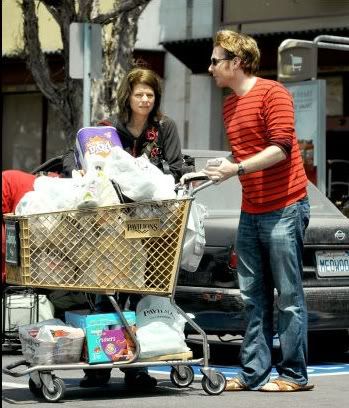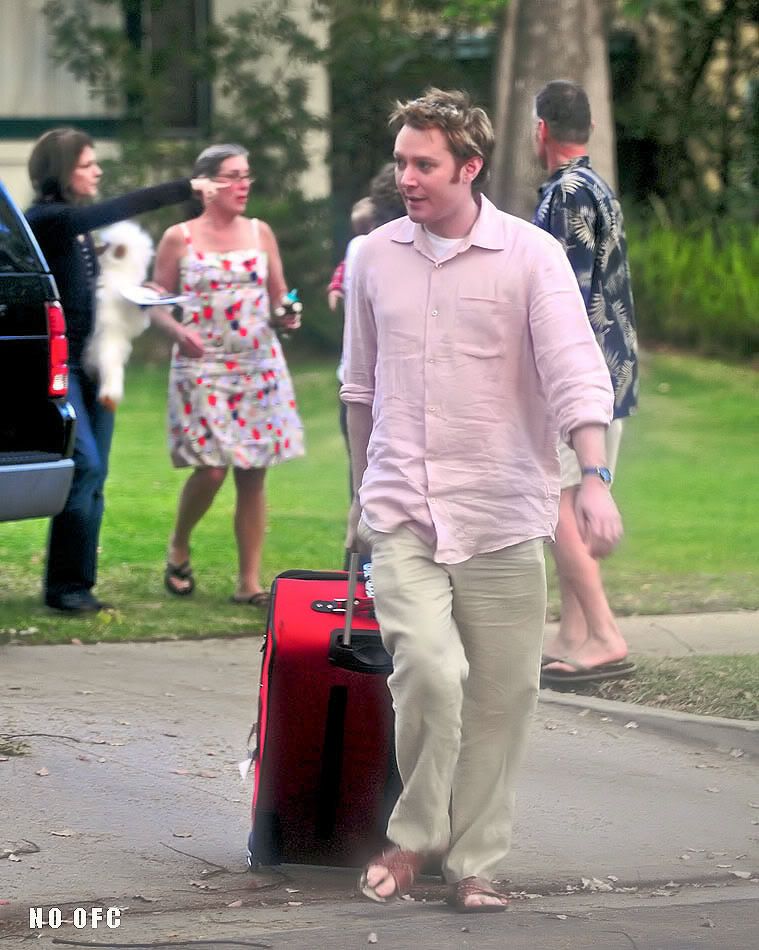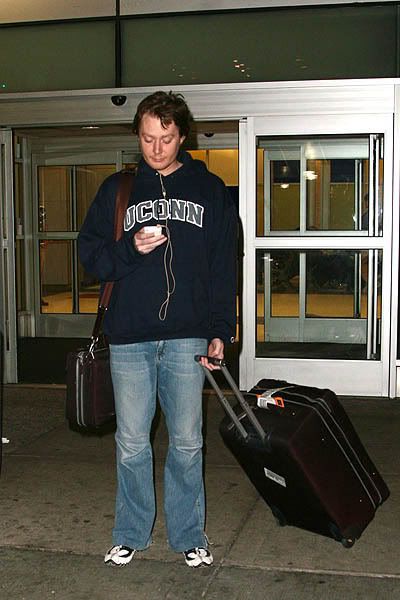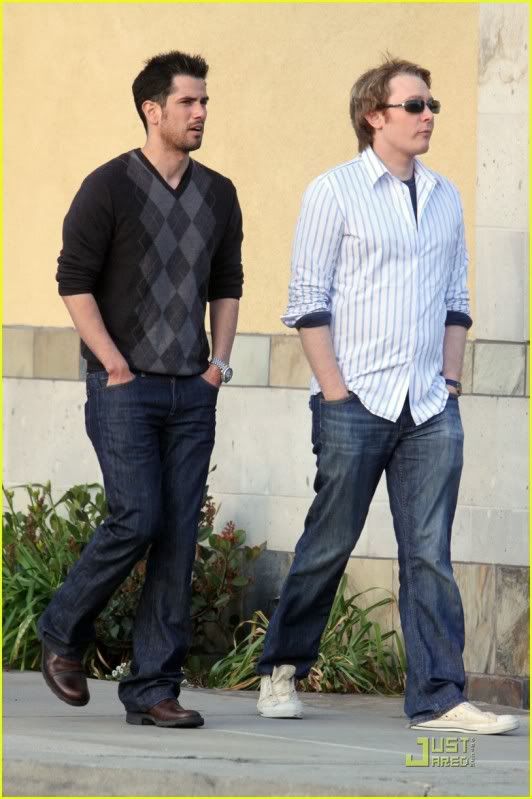 The worldwide obsession with celebrities has generated one of the most fascinating and feared parts of our culture today, the paparazzi. Paparazzi are photographers who constantly hunt celebrities, public figures and their families, trying to photograph them in candid, unflattering and, at times, compromising moments.
The worldwide obsession with celebrities has generated one of the most fascinating and feared parts of our culture today, the paparazzi. Paparazzi are photographers who constantly hunt celebrities, public figures and their families, trying to photograph them in candid, unflattering and, at times, compromising moments.
Most people who are a fan of a star love to see candid pictures of their celebrity. Clay Aiken has had many pictures taken of his every move. Recently, we have seen him at an airport, a family visit, grocery shopping, eating in a restaurant with his son and a visit to a business office. I would imagine many of those pictures have been saved on a lot of computers. But, as much as we love the pictures, are we then, part of the problem of paparazzi?
 Paparazzi work alone or in teams and they rarely work for any one company. They make money by selling their photos and videos of well-known people to publications around the world. The most popular of the publications include The National Enquirer, The Globe, The Star, People, US Weekly, OK!, In Touch, Entertainment Tonight, The Insider, Access Hollywood, TMZ, and Hollywood.TV.
Paparazzi work alone or in teams and they rarely work for any one company. They make money by selling their photos and videos of well-known people to publications around the world. The most popular of the publications include The National Enquirer, The Globe, The Star, People, US Weekly, OK!, In Touch, Entertainment Tonight, The Insider, Access Hollywood, TMZ, and Hollywood.TV.
One photo or video clip will often be sold over and over to many different publications. This is very lucrative as, according to Hitwise, there are over 1,200 celebrity news sites in the U.S. The monetary rewards increase tremendously when the paparazzi are able to capture something unique regarding someone famous. The most unique shots of famous stars can make millions for the photographer. Unfortunately, in this case, unique means something that makes the celebrity look bad: a car accident, drinking too much, tripping and falling, looking overweight, getting angry, having a bad hair day, are all unique to the magazines. Since the payoff can be huge, paparazzi teams work 24/7 on many top celebrities hoping to become rich capturing the one “special” moment on film or video. It was reported that one paparazzo made $80,000 for eight seconds of tape when he caught on videotape a famous actor crashing his car.
It is important for the paparazzi to know the whereabouts of the celebrities so they try to get as many contacts as they can. They try to get a friend or assistant to help them out. They also have financial arrangements with doormen, waiters, bar tenders, valet attendants, and limo drivers who just might know the location of a celebrity.
Because of the monetary rewards, paparazzi compete with each other to get the very best, most unique photos. According to The Paparazzi Reform Initiative,
Teams of paparazzi in SUVs will surround a celebrity driving down the street or freeway to ensure no competing paparazzi in cars can pull up and get footage. Sometimes there are 30 cars chasing a celebrity, all of them ignoring stop lights and at times driving on the wrong side of the street as they all jockey to get the best position to get a photo. Out of their cars and on foot, they push and shove while blocking walkways in shopping areas, along sidewalks and in parking lots. No one is licensed. Anyone can be a “paparazzi”. It is like the gold rush or the Wild West before law and order arrived.
 Paparazzi are not photo-journalists. They are not members of the disciplined profession that belongs to the field of journalism. A photo-journalist is just that, a journalist, who works for a legitimate news organization and takes photos of news-worthy events such as sporting events, political speeches, award shows, military conflicts, etc. These professionals have undergone background checks and have been issued credentials. They do not participate in chasing a celebrity down the street in the hope of getting a scandalous photo.
Paparazzi are not photo-journalists. They are not members of the disciplined profession that belongs to the field of journalism. A photo-journalist is just that, a journalist, who works for a legitimate news organization and takes photos of news-worthy events such as sporting events, political speeches, award shows, military conflicts, etc. These professionals have undergone background checks and have been issued credentials. They do not participate in chasing a celebrity down the street in the hope of getting a scandalous photo.
A huge change in the paparazzi industry is beginning to emerge. The paparazzi population is about to explode from hundreds or even thousands to millions. The Paparazzi Reform Initiative says:
Since almost everyone today is armed with a phone able to take photos and video, the tabloid industry is trying to turn us all – tourists, club-goers, shoppers, neighbors, taxi drivers, stewardesses, nurses, gardeners, nannies, etc. – into one massive ubiquitous paparazzi mob. Media outlets are encouraging viewers to send in their celebrity photos and websites have sprung up willing to act as photo brokers. In a recent 20/20 report, US WEEKLY reported receiving 10,000-15,000 photos overnight. In the end, the media wins by getting more photos for less cost.
 It used to be that the tabloids had one standard for what they were willing to publish and the rest of the media had a higher standard. Due to the decrease in circulation numbers, mainstream magazines are now publishing questionable photos.
It used to be that the tabloids had one standard for what they were willing to publish and the rest of the media had a higher standard. Due to the decrease in circulation numbers, mainstream magazines are now publishing questionable photos.
Did you know that there is a PAPARAZZI UNIVERSITY? It claims to teach anyone the “skill” of being a paparazzo. In one class assignment, 10 students, led by an “instructor” are sent out to find celebrities shopping along Rodeo Drive so they can photograph them.
Soon, celebrities will have no place they can be without a mob with cameras recording every moment.
It is basic human nature that when someone is doing something they shouldn’t, they try to justify their actions. These justifications are rampant in the paparazzi industry. They are so pervasive that most people have heard them and probably repeat them:
“Well, that’s the price of fame.”
“This celebrity is of interest to our audience.”
“I’m just doing my job.”
“The public want it.”
“The celebrities should know what they are getting into when they become famous.”
“I helped make them famous – they owe me.”
Every day, the courts are filled with similar justifications from arsonists, pedophiles, drug dealers and even the tobacco industry.
The real truth is that the paparazzi violate one of the basic human rights, the right to privacy. It cannot be imagined that anyone would want the same treatment for their wives, husbands, sons, daughters or even themselves.
According to The Paparazzi Reform Initiative, there is one way to prevent the paparazzi from hounding people who wish to be left alone. They believe that it is necessary to:
pass new legislation, or get legal precedent set, that grants all persons the legal right to how and where his or her likeness can be used. This restriction already exists in commercial law – the right to use someone’s likeness for commercial purposes must be granted by that individual. Nike could not use Kobe Bryant’s picture in a shoe commercial without his permission. If Nike failed to do this, Mr. Bryant could get recourse via the court system. This has long been established.
 A law that allows people the right to choose how or where their likeness is used would solve the paparazzi problem. Those that wanted their photos in the tabloid press would grant permission for them to be used. Those who didn’t want it, would have that right as well.
A law that allows people the right to choose how or where their likeness is used would solve the paparazzi problem. Those that wanted their photos in the tabloid press would grant permission for them to be used. Those who didn’t want it, would have that right as well.
Yes, we would miss the wonderful pictures of Clay, but we would also know that he can walk out of his house and visit the grocery store without being surrounded by rabid cameramen.
